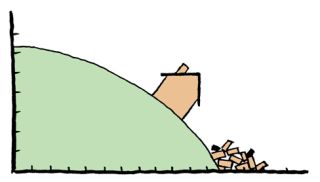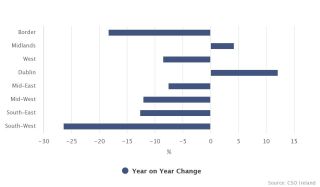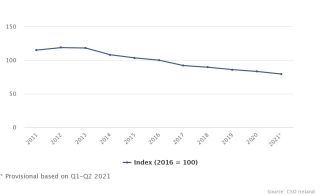Little Housing for All as new dwelling completions fall

According to the latest data from the Central Statistics Office (CSO), new dwelling completions fell by 7.7 per cent in Q3 2021, compared to the same period last year. Less than 5,000 homes were completed between July and September this, year bringing the total number of completions for first nine months to just 13,574, almost 20,000 below the Housing for All target of 33,000 per year. That's a lot of making up to do in the last three months of the year.
Housing Types
The number of single homes declined by 18.1 per cent compared to Q3 2021, from 1,463 to 1,198. The number of scheme homes also declined, this time by 14.3 per cent, from 2,867 to 2,458. The number of apartments, however, rose by 39.9% from 715 to 1,000. Notwithstanding the decline in scheme housing compared to Q3 last year, the scheme dwellings account for over half of all new dwelling completions in Q3 2021.
Urban / Rural Divide
While shown to be flawed, the ESB Networks new domestic connections dataset continues to be used as the primary source of data on new dwelling completions. After it was proven to overestimate new dwellng completions, the CSO build adjustments into its reporting using additional data from the ESB and other data sources, however it is still the dataset relied upon in more in-depth analyses.
This data shows that, in Q3 2021, the number of urban dwelling completions fell by 5 per cent to 3,617, compared to 3,806 in Q2 2020. In rural areas, there was an even greater decline, of 16.1 per cent, from 1,239 in Q3 2020, to just 1,039 this year. More than three in four new dwelling completions (77 per cent) in Q3 this year were in urban areas, compared to just 22.3 per cent in rural areas. This compares to 75.4 per cent and 24.6 per cent respectively in the same quarter in 2020.
Regional Change
Dublin (+12.1 per cent) and the Midlands (+4.2 per cent) experienced the highest rate of increase, while the South-West (-26.4 per cent), Border (-18.4 per cent), and South-East (-12.7 per cent) had the largest decreases.
Figure 1: Year on Year Percentage Change of New Dwelling Completions by Region (Q3 2020 - Q3 2021)

Building Smaller
Average new dwelling size is also falling gradually year on year. According to the CSO, the decline in the average new dwelling size index is drive by both an increase in the proportion of completed dwellings being apartments (22 per cent for the first three quarters of 2021) and also a decrase in the size of single and scheme dwellings. Overall, the provisional data from the new dwelling size index for 2021 shows a decrease of 21 per cent on 2016 sizes.
Figure 2: Average new dwelling size index 2011-2021

Based on this most recent data, there is a long way to go before dwelling completions reach the target of 33,000 per annum. Meanwhile, some 122,000 households - including households on the social housing waiting lists and those in private tenancies and in receipt of the Housing Assistance Payment, continue to be left behind.